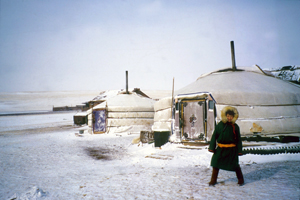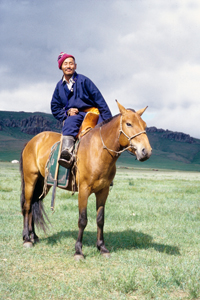
Perspectives
By Linda Gardelle, sociologist, of whom the works concern more specifically some questions about nomadic pastoralism in Mongolia and in the Sahara desert.
At the dawn of the 1990s, Mongolia was democratised and became open to the market economy, getting free from seventy-seven years of soviet trusteeship, through which the whole society was reorganised according to collectivist principles and the unique party domination. The educational, sanitary, and commercial infrastructures put in place during the soviet period quickly suffered as a result of the disengagement of the Government and of the ending of financial help from the Soviet Union. Lots of companies closed and thousands of Mongolians became unemployed. In conjunction with this phenomenon, a climate of nationalist renewal grew and the nomadic pastoralism became the most important symbol of Mongolian culture. In this nationalist impulsion, lots of inhabitants of urban areas turned themselves into a new lifestyle of breeders: they decided to join the steppe and to adopt their ancestors’ lifestyle. This could happen because of the cattle’s privatisation, which was formerly collectivist during the communist period.
In the media, in the political speeches, in the class books, and in the artistic domain, the nomadic lifestyle is, since 1991, the symbol of the Mongolian cultures, despite the multiple problems that the breeders have to face.
Multiples difficulties

The climate changes are the other problem that they have to adapt to. The last years were marked by a significant increase of average yearly temperature and by a dislocation of the precipitation’s calendar. These two phenomena have important repercussions on the ecosystem.
Many breeders turn out to be vulnerable to these climate hazards: inexperienced, having only their ancestors’ savoir-faire, they can lose their whole herd because of a harsh winter. That is what we could see during THE 2000, 2001 and 2002 winters, during which millions of cattle lost their lives.
Finally, the geographic remoteness in comparison with Ulaan Baatar, the capital, is not often appreciated by the breeders, who are still open-minded and very curious about the outside world. They do care about the scholarship of their children, a service that was well-assured during the communist period.
Some efforts to adapt
A certain amount of young rural people, mostly girls, dream of studying in town, and of working in it. There is also a lot of young Mongolians who find their happiness in the nomadic lifestyle and who are proud of their breeder’s job.
For a few years, nomadic families try to equip their yurt with a solar panel. Lots of young breeders proclaim loud and clear that, thanks to a TV and a Satellite, they are not cut off anymore from the outside world and have nothing to envy the cities’ inhabitants.

What kind of future for Mongolian nomads?
Contrary to what we often hear or read about the future decline of Mongolian nomadism, it appears to be really solid. I have been working for ten years on this question; the nomadic pastoralism will endure in the Mongolian steppes as long as three important elements are still present. First of all, the Mongolian government should keep the strength to develop the breeding domain and to develop some rural areas. Secondly, Mongolian nomadism will endure if the breeders have the will to continue to live this kind of life. According to me, they will have this will as long as they feel valorised like they are today, and as long as they will have the possibility to live comfortably. Finally, and most importantly, the main danger for Mongolian breeders is still the climate changes provoked by the global warming of our planet. About this point, we can say the industrialised countries have their fate in their hands.
